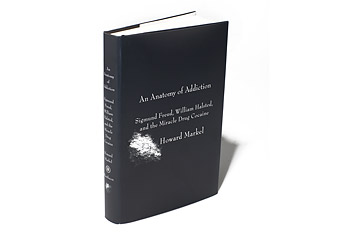
An Anatomy of Addiction by Howard Markel
On Sept. 15, 1884, in Heidelberg, Germany, a demonstration took place that electrified the European medical establishment. An audience of distinguished eye surgeons at a medical conference watched as a dog was brought on stage. A doctor squeezed a few drops of a clear liquid into the dog's left eye, leaving its right eye clear. When the doctor waved his forceps in front of the dog's right eye, it naturally flinched. Then the doctor lightly touched his forceps to the surface of the dog's left eye. It didn't even blink.
The audience erupted. They had just witnessed one of the great moments in the history of anesthesia. The wonder drug was cocaine.
But it wasn't the cocaine we know today. When we first meet it in the distinguished medical historian Howard Markel's rich, revelatory new book, it's something else entirely. Markel's An Anatomy of Addiction: Sigmund Freud, William Halsted, and the Miracle Drug Cocaine is like the early pages of a family photo album, showing us cocaine as it has not been seen for over 100 years. The drug was pharmaceutically pure enough, to be sure, and plenty potent, but cocaine is now an institution, with its own politics and its own economics and its own malevolent cultural mythology. Back then it was just a novel chemical compound like any other: innocent, newly refined, culturally neutral, stripped of any meaning, its future bright and still full of promise.
Of course, cocaine wasn't really new. It had been present in the leaves of the coca plant, which has grown in the Andes and the Amazon basin for millennia. Indigenous people there chewed them for a mild buzz, with no ill effects. In some ways the most startling pages of Markel's book are the early passages, in which he shows us how Western science took those unremarkable pale green leaves and turned them into a catastrophe. In 1860 a German graduate student figured out how to refine the active component in the leaves into its familiar crystalline form, and it quickly became a fad — a French chemist named Angelo Mariani made a fortune selling it mixed with red wine. His Vin Mariani was endorsed by, among others, Queen Victoria, U.S. President William McKinley and Pope Leo XIII. (Mariani ultimately lost out to the American claimant Coca-Cola, now available in de-cocainized form.)
Vin Mariani was a relatively weak solution. The first people who used cocaine in significant quantities and concentrations were, naturally, doctors, and they became its first victims. As it turns out, the drug chose its victims from an exclusive list. One of them was a brilliant American surgeon named William Halsted, who would revolutionize his field. Another was an equally brilliant Viennese doctor named Sigmund Freud.
In 1884, Freud was a poor and obscure but wildly ambitious young doctor trying to scrape together enough kreuzers to marry his posh fiancée. In his first encounter with cocaine, he used it to try to wean an addicted colleague off morphine. Freud had no idea how addictive the new drug was, but his friend found out pretty quick: he became dependent on both cocaine and morphine, and he eventually went mad and died. The experience haunted Freud for the rest of his life, but it didn't stop him from continuing to experiment with the wonder drug on himself. In fact, he loved the stuff. "In my last severe depression," he wrote to his fiancée, "I took coca again, and a small dose lifted me to the heights in a wonderful fashion. I am just now collecting the literature for a song of praise to this magical substance." That song would become the monograph Über Coca, Freud's first major publication.
